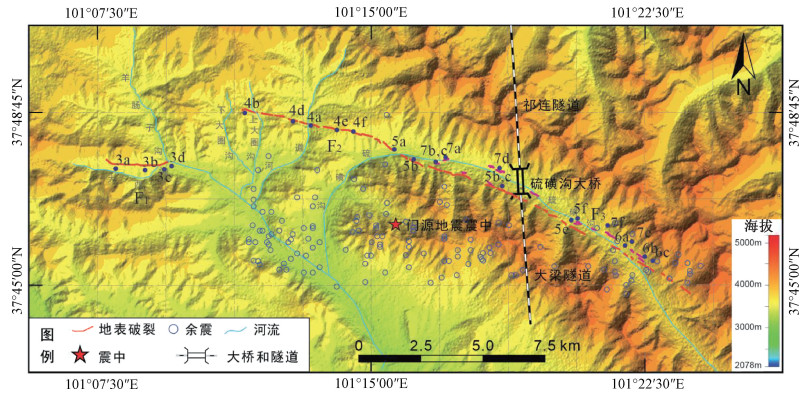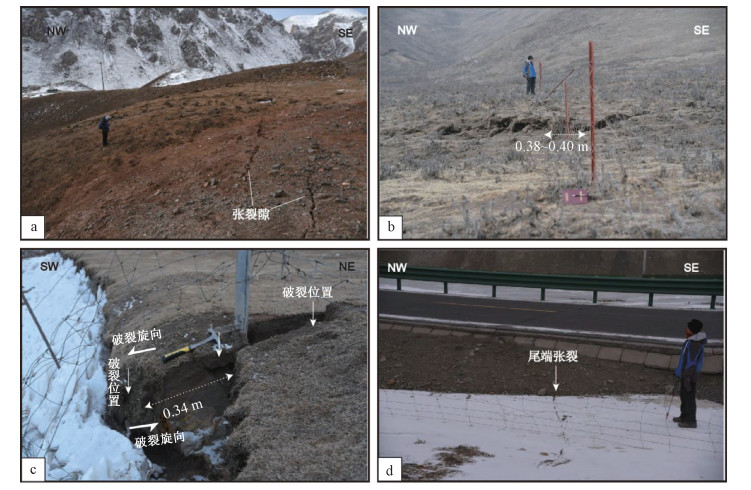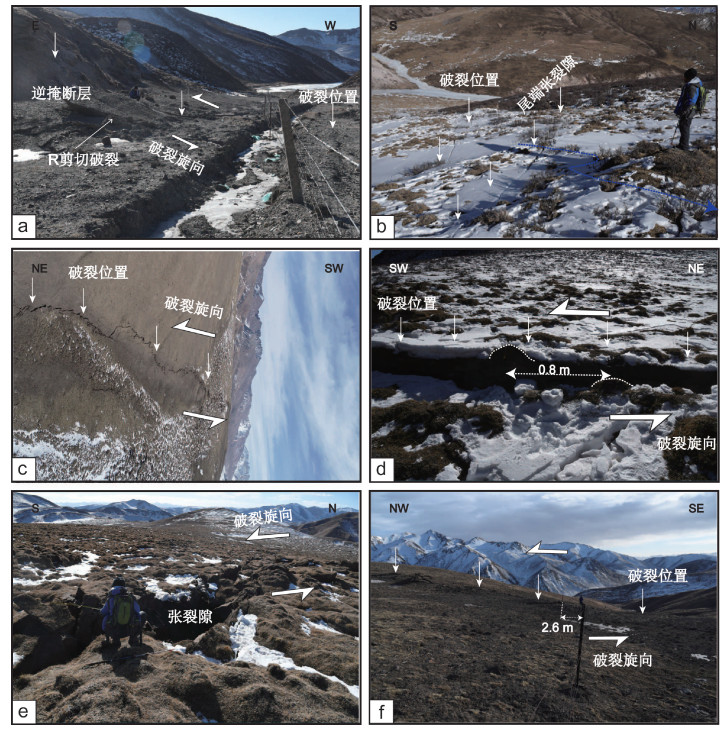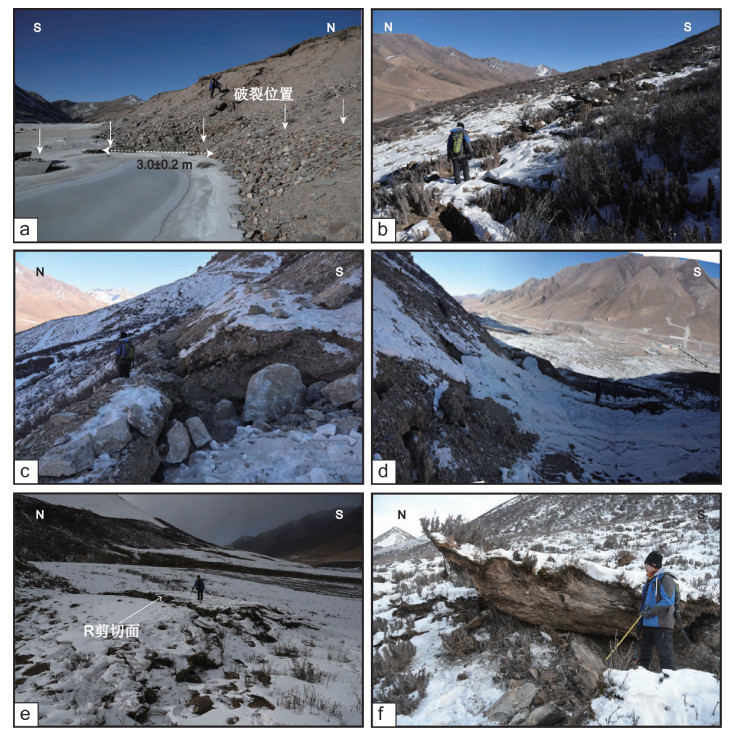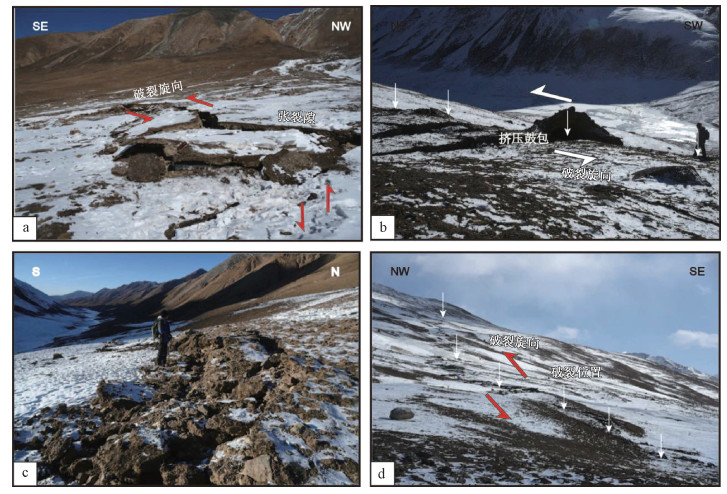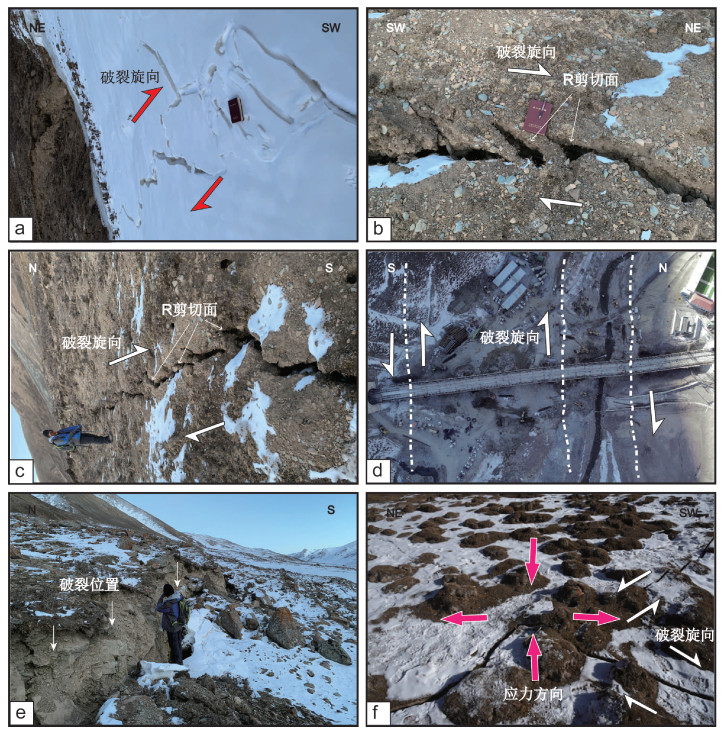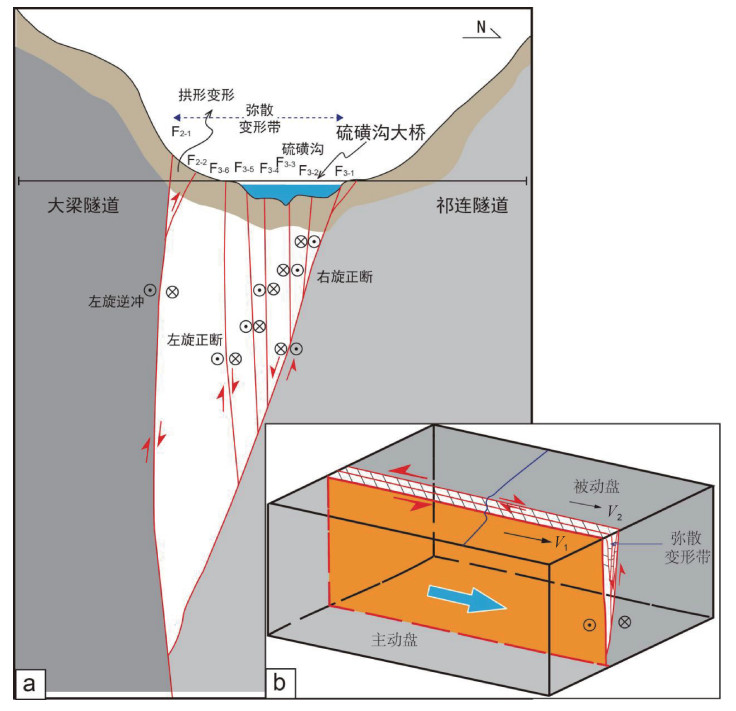Surface rupture investigation of the 2022 Menyuan MS 6.9 Earthquake, Qinghai, China: Implications for the fault behavior of the Lenglongling fault and regional intense earthquake risk
-
摘要:
2022年1月8日青海门源MS 6.9地震发生在青藏高原东北缘的祁连山断块内部,仪器震中位于海原活动断裂系西段的冷龙岭断裂带上,是该断裂系自1920年海原8.5级大地震后再次发生M>6.5的强震。考察结果的初步总结表明,此次门源地震产生了呈左阶斜列分布、总长度近23 km的南北两条破裂,在两者之间存在长约3.2 km、宽近2 km的地表破裂空区。南支破裂(F1)出现在托来山断裂的东段,走向91°,长约2.4 km,以兼具向南逆冲的左旋走滑变形为主,最大走滑位移近0.4 m。北支主破裂(F2)出现在冷龙岭断裂的西段,总长度近20 km,以左旋走滑变形为主,呈整体微凸向北东的弧形展布,包含了走向分别为102°、109°和118°的西、中、东三段,最大走滑位移出现在中段,为3.0±0.2 m。此外,在北支主破裂中—东段的北侧新发现一条累计长度约7.6 km、以右旋正断为主的北支次级破裂(F3),累计最大走滑量约0.8 m,最大正断位移约1.5 m。综合分析认为,整个同震破裂以左旋走滑变形为主,具有双侧破裂特点,宏观震中位于北支主破裂的中段,其地表走滑位移很大可能与震源破裂深度浅有关,其中的右旋正断次级破裂可能是南侧主动盘向东运移过程中拖曳北侧块体发生差异运动所引起的特殊变形现象。印度与欧亚板块近南北向强烈碰撞挤压导致南祁连断块沿海原左旋走滑断裂系向东挤出,从而引发该断裂系中的托来山断裂与冷龙岭断裂同时发生破裂,成为导致此次强震的主要动力机制。在此大陆动力学背景下,以海原左旋走滑断裂系为主边界的祁连山断块及其周边的未来强震危险性需得到进一步重视。
-
关键词:
- 门源MS 6.9地震 /
- 冷龙岭断裂 /
- 同震地表破裂带 /
- 海原左旋走滑断裂系统 /
- 祁连山断块
Abstract:The MS 6.9 Menyuan earthquake on January 8, 2022 occurred in the Qilian Mountain fault block in the northeastern margin of the Xizang Plateau. The instrumental epicenter is located in the Lenglongling fault zone in the west section of the Haiyuan active fault system. It is another strong earthquake with M>6.5 that occurred in the fault system after the Haiyuan M 8.5 earthquake in 1920. The preliminary conclusion of the investigation results shows that the Menyuan earthquake generated two main fracture zones in the south and north separately, which are distributed in left-step oblique arrangement with a total length of nearly 23 km, and there is a surface rupture cavity with a length of about 3.2 km and a width of nearly 2 km between them. The south branch rupture (F1) appears in the east section of the Tuolaishan fault, striking 91°, with a length of about 2.4 km. It is mainly characterized by southward thrust and sinistral strike slip, with a maximum horizontal displacement of nearly 0.4 m. The north branch main rupture (F2) appears in the west section of the Lenglongling fault, with a total length of nearly 20 km. It is mainly sinistral strike-slip deformation, and presents an overall slightly convex arc distribution to the northeast, including the west, middle and east sections of 102°, 109° and 118°, respectively. The maximum strike-slip displacement occurs in the middle section, which is 3.0±0.2 m. In addition, a new north branch secondary fault (F3) with a cumulative length of about 7.6 km, dominated by normal-dextral fault, is discovered on the north side of the middle to east section of the main fault of the north branch, with a cumulative maximum horizontal displacement of about 0.8 m and a maximum normal vertical displacement of about 1.5 m. Comprehensively, the whole coseismic rupture is mainly sinistral strike-slip and has the characteristics of bilateral rupture, whereas the macroscopic epicenter is located in the north branch of midway through the main fracture zone, thus the strike-slip displacement of the surface may be associated with the shallow rupture of the source. The normal-dextral rupture is likely to be caused by the differential movement of the north block dragged by the active south plate. The south Qilian block was extruded eastward along the Haiyuan sinistral strike-slip fault system due to the strong collision and compression between the Indian and Eurasian plates, which led to the simultaneous rupture of the Tuolaishan fault and the Lenglongling fault. This is the main dynamic mechanism leading to the strong earthquake. Under the background of continental dynamics, further attention should be paid to the future strong earthquake risk of the Qilian Mountain fault block and its surrounding area with the Haiyuan sinistral strike-slip fault system as the main boundary.
-

-
图 3 南支破裂(F1)野外照片(位置见图 2)
Figure 3.
图 4 北支主破裂(F2)西段野外照片(位置见图 2)
Figure 4.
图 5 北支主破裂(F2)中段野外照片(位置见图 2)
Figure 5.
图 6 北支主破裂(F2)东段野外照片(位置见图 2)
Figure 6.
图 7 同震破裂带右旋张剪北支次级破裂(F3)野外照片(位置见图 2)
Figure 7.
-
DENG Q D, CHENG S P, MA J, et al., 2014. Seismic activities and earthquake potential in the Xizang Plateau[J]. Chinese Journal of Geophysics, 57(7): 2025-2042. (in Chinese with English abstract) http://en.cnki.com.cn/Article_en/CJFDTotal-DQWX201407001.htm
GAI H L, YAO S H, YANG L P, et al., 2021. Characteristics and causes of coseismic surface rupture triggered by the "5.22" MS7.4 Earthquake in Maduo, Qinghai, and their significance[J]. Journal of Geomechanics, 27(6): 899-912. (in Chinese with English abstract)
GAO R, WANG H Y, WANG C S, et al., 2011. Lithospheric deformation shortening of the northeastern Xizang Plateau: evidence from reprocessing of deep seismic reflection data[J]. Acta Geoscientia Sinica, 32(5): 513-520. (in Chinese with English abstract)
GAUDEMER Y, TAPPONNIER P, MEYER B, et al., 1995. Partitioning of crustal slip between linked, active faults in the eastern Qilian Shan, and evidence for a major seismic gap, the 'Tianzhu gap', on the western Haiyuan Fault, Gansu (China)[J]. Geophysical Journal International, 120(3): 599-645, doi: 10.1111/j.1365-246X.1995.tb01842.x.
GUO A N, LI X, BAI X J, et al., 2016. The Menyuan, Qinghai MS6.4 Earthquake on 21 January 2016 and its related parameters[J]. China Earthquake Engineering Journal, 38(1): 150-158. (in Chinese with English abstract)
GUO P, HAN Z J, DONG S P, et al., 2019a. Surface rupture and slip distribution along the Lenglongling fault in the NE Xizang Plateau: implications for faulting behavior[J]. Journal of Asian Earth Sciences, 172: 190-207, doi: 10.1016/j.jseaes.2018.09.008.
GUO P, HAN Z J, MAO Z B, et al., 2019b. Paleoearthquakes and rupture behavior of the Lenglongling fault: Implications for seismic hazards of the northeastern margin of the Xizang Plateau[J]. Journal of Geophysical Research: Solid Earth, 124(2): 1520-1543, doi: 10.1029/2018JB016586.
HE W G, LIU B C, YUAN D Y, et al., 2000. Research on slip rates of the Lenglongling active fault zone[J]. Northwestern Seismological Journal, 22(1): 90-97. (in Chinese with English abstract)
HE W G, YUAN D Y, GE W P, et al., 2010. Determination of the slip rate of the Lenglongling fault in the middle and eastern segments of the Qilian mountain active fault zone[J]. Earthquake, 30(1): 131-137. (in Chinese with English abstract)
HU C Z, YANG P X, LI Z M, et al., 2016. Seismogenic mechanism of the 21 January 2016 Menyuan, Qinghai MS6.4 earthquake[J]. Chinese Journal of Geophysics, 59(5): 1637-1646. (in Chinese with English abstract)
JIA S X, ZHANG X K, 2008. Study on the crust phases of deep seismic sounding experiments and fine crust structures in the northeast margin of Xizang plateau[J]. Chinese Journal of Geophysics, 51(5): 1431-1443. (in Chinese with English abstract) http://www.oalib.com/paper/1568190
JIANG W L, LI Y S, TIAN Y F, et al., 2017. Research of seismogenic structure of the menyuan MS6.4 earthquake on January 21, 2016 in Lenglongling area of ne Xizang Plateau[J]. Seismology and Geology, 39(3): 536-549. (in Chinese with English abstract)
LASSERRE C, MOREL P H, GAUDEMER Y, et al., 1999. Postglacial left slip rate and past occurrence of M≥8 earthquakes on the Western Haiyuan Fault, Gansu, China[J]. Journal of Geophysical Research: Solid Earth, 104(B8): 17633-17651, doi: 10.1029/1998JB900082.
LI Y L, WANG C S, DAI J E, et al., 2015. Propagation of the deformation and growth of the Xizang-Himalayan orogen: a review[J]. Earth-Science Reviews, 143: 36-61, doi: 10.1016/j.earscirev.2015.01.001
LIU Z, LI B, HE K, et al., 2020. An analysis of dynamic response characteristics of the Yigong landslide in Xizang under strong earthquake[J]. Journal of Geomechanics, 26(4): 471-480. (in Chinese with English abstract)
MA B Q, LI D W, 2008. Stages of the neotectonic movement of the Menyuan basin in the middle segment of the Qilian mountains[J]. Journal of Geomechanics, 14(3): 201-211. (in Chinese with English abstract) http://en.cnki.com.cn/Article_en/CJFDTOTAL-DZLX200803004.htm
PAN J W, BAI M K, LI C, et al., 2021. Coseismic surface rupture and seismogenic structure of the 2021-05-22 Maduo (Qinghai) MS7.4 earthquake[J]. Acta Geologica Sinica, 95(6): 1655-1670. (in Chinese with English abstract)
PELTZER G, TAPPONNIER P, 1988. Formation and evolution of strike-slip faults, rifts, and basins during the India-Asia Collision: an experimental approach[J]. Journal of Geophysical Research: Solid Earth, 93(B12): 15085-15117, doi: 10.1029/JB093iB12p15085.
TAPPONNIER P, XU Z Q, ROGER F, et al., 2001. Oblique stepwise rise and growth of the Xizang Plateau[J]. Science, 294(5547): 1671-1677, doi: 10.1126/science.105978.
WELLS D L, COPPERSMITH K J, 1994. New empirical relationships among magnitude, rupture length, rupture width, rupture area, and surface displacement[J]. Bulletin of the Seismological Society of America, 84(4): 974-1002, doi: 10.1785/BSSA0840040974.
WU Z H, ZHAO G M, 2013. The earthquake prediction status and related problems: a review[J]. Geological Bulletin of China, 32(10): 1493-1512. (in Chinese with English abstract) http://en.cnki.com.cn/Article_en/CJFDTOTAL-ZQYD201310002.htm
WU Z H, ZHAO G M, LONG C X, et al., 2014. The seismic hazard assessment around South-East area of Qinghai-Xizang plateau: a preliminary results from active tectonics system analysis[J]. Acta Geologica Sinica, 88(8): 1401-1416. (in Chinese with English abstract)
WU Z H, ZHAO G M, LIU J, 2016. Tectonic genesis of the 2015 Ms8.1 Nepal great earthquake and its influence on future strong earthquake tendency of Xizang Plateau and its adjacent region[J]. Acta Geologica Sinica, 90(6): 1062-1085. (in Chinese with English abstract) http://www.researchgate.net/publication/324493674_2015niannipoerMs81dezhengouzaochengyinjiduiqingcanggaoyuanjilinquweilaiqiangzhenqushideyingxiang2015175
XIA Y, 2015. The faulting tectonics and it's evolution in Tuolai river of Qilian mountain since the Mesozoic[D]. Beijing: China University of Geosciences (Beijing). (in Chinese)
YUAN D Y, LIU B C, LV T Y, et al., 1998. Study on the segmentation in east segment of the northern Qilianshan fault zone[J]. Northwestern Seismological Journal, 20(4): 27-34. (in Chinese with English abstract) http://en.cnki.com.cn/Article_en/CJFDTOTAL-ZBDZ199804003.htm
YUAN D Y, ZHANG P Z, LIU B C, et al., 2004. Geometrical imagery and tectonic transformation of late quaternary active tectonics in northeastern margin of Qinghai-Xizang Plateau[J]. Acta Geologica Sinica, 78(2): 270-278. (in Chinese with English abstract)
YUAN D Y, GE W P, CHEN Z W, et al., 2013. The growth of northeastern Xizang and its relevance to large-scale continental geodynamics: a review of recent studies[J]. Tectonics, 32(5): 1358-1370, doi: 10.1002/tect.20081.
ZHAO G M, WU Z H, LIU J, 2020. The types, characteristics and mechanism of seismic migration[J]. Journal of Geomechanics, 26(1): 13-32. (in Chinese with English abstract)
ZHAO Q, WANG S X, JIANG F Y, et al., 2017. Coseismic deformation field and fault slip distribution of the 2016 Qinghai Menyuan MW5.9 earthquake from InSAR measurement[J]. Earthquake, 37(2): 96-105. (in Chinese with English abstract)
ZHENG W J, YUAN D Y, HE W G, 2004. Characteristics of Palaeo-earthquake activity along the active Tianqiaogou-Huangyangchuan fault on the eastern section of the Qilianshan mountains[J]. Seismology and Geology, 26(4): 645-657. (in Chinese with English abstract)
ZHOU C J, WU Z H, NIMA C R, et al., 2014. Structural analysis of the co-seismic surface ruptures associated with the Yushu Ms7.1 earthquake, Qinghai Province[J]. Geological Bulletin of China, 33(4): 551-566. (in Chinese with English abstract)
邓起东, 程绍平, 马冀, 等, 2014. 青藏高原地震活动特征及当前地震活动形势[J]. 地球物理学报, 57(7): 2025-2042. https://www.cnki.com.cn/Article/CJFDTOTAL-DQWX201407001.htm
盖海龙, 姚生海, 杨丽萍, 等, 2021. 青海玛多"5·22"MS7.4级地震的同震地表破裂特征、成因及意义[J]. 地质力学学报, 27(6): 899-912. https://journal.geomech.ac.cn/cn/article/doi/10.12090/j.issn.1006-6616.2021.27.06.073
高锐, 王海燕, 王成善, 等, 2011. 青藏高原东北缘岩石圈缩短变形: 深地震反射剖面再处理提供的证据[J]. 地球学报, 32(5): 513-520. doi: 10.3975/cagsb.2011.05.01
郭安宁, 李鑫, 白雪见, 等, 2016. 2016年1月21日青海门源6.4级地震及相关参数[J]. 地震工程学报, 38(1): 150-158. doi: 10.3969/j.issn.1000-0844.2016.01.0150
何文贵, 刘百篪, 袁道阳, 等, 2000. 冷龙岭活动断裂的滑动速率研究[J]. 西北地震学报, 22(1): 90-97. https://www.cnki.com.cn/Article/CJFDTOTAL-ZBDZ200001017.htm
何文贵, 袁道阳, 葛伟鹏, 等, 2010. 祁连山活动断裂带中东段冷龙岭断裂滑动速率的精确厘定[J]. 地震, 30(1): 131-137. doi: 10.3969/j.issn.1000-3274.2010.01.015
胡朝忠, 杨攀新, 李智敏, 等, 2016. 2016年1月21日青海门源6.4级地震的发震机制探讨[J]. 地球物理学报, 59(5): 1637-1646. https://www.cnki.com.cn/Article/CJFDTOTAL-DQWX201605009.htm
嘉世旭, 张先康, 2008. 青藏高原东北缘深地震测深震相研究与地壳细结构[J]. 地球物理学报, 51(5): 1431-1443. doi: 10.3321/j.issn:0001-5733.2008.05.016
姜文亮, 李永生, 田云锋, 等, 2017. 冷龙岭地区2016年青海门源6.4级地震发震构造特征[J]. 地震地质, 39(3): 536-549. doi: 10.3969/j.issn.0253-4967.2017.03.007
刘铮, 李滨, 贺凯, 等, 2020. 地震作用下西藏易贡滑坡动力响应特征分析[J]. 地质力学学报, 26(4): 471-480. https://journal.geomech.ac.cn/cn/article/doi/10.12090/j.issn.1006-6616.2020.26.04.040
马保起, 李德文, 2008. 祁连山中段门源盆地新构造运动的阶段划分[J]. 地质力学学报, 14(3): 201-211. doi: 10.3969/j.issn.1006-6616.2008.03.002 https://journal.geomech.ac.cn/article/id/4e6b4c3c-e6ca-4154-bbd0-31fe43833adc
潘家伟, 白明坤, 李超, 等, 2021. 2021年5月22日青海玛多MS7.4地震地表破裂带及发震构造[J]. 地质学报, 95(6): 1655-1670. doi: 10.3969/j.issn.0001-5717.2021.06.001
吴中海, 赵根模, 2013. 地震预报现状及相关问题综述[J]. 地质通报, 32(10): 1493-1512. doi: 10.3969/j.issn.1671-2552.2013.10.002
吴中海, 赵根模, 龙长兴, 等, 2014. 青藏高原东南缘现今大震活动特征及其趋势: 活动构造体系角度的初步分析结果[J]. 地质学报, 88(8): 1401-1416. https://www.cnki.com.cn/Article/CJFDTOTAL-DZXE201408004.htm
吴中海, 赵根模, 刘杰, 2016. 2015年尼泊尔Ms8.1地震构造成因及对青藏高原及邻区未来强震趋势的影响[J]. 地质学报, 90(6): 1062-1085. doi: 10.3969/j.issn.0001-5717.2016.06.002
夏阳, 2015. 祁连山托来河地区中生代以来的断裂构造及其演化[D]. 北京: 中国地质大学(北京).
袁道阳, 刘百篪, 吕太乙, 等, 1998. 北祁连山东段活动断裂带的分段性研究[J]. 西北地震学报, 20(4): 27-34. https://www.cnki.com.cn/Article/CJFDTOTAL-ZBDZ199804003.htm
袁道阳, 张培震, 刘百篪, 等, 2004. 青藏高原东北缘晚第四纪活动构造的几何图像与构造转换[J]. 地质学报, 78(2): 270-278. doi: 10.3321/j.issn:0001-5717.2004.02.017
赵根模, 吴中海, 刘杰, 2020. 地震迁移的类型、特征及机制讨论[J]. 地质力学学报, 26(1): 13-32. https://journal.geomech.ac.cn/cn/article/doi/10.12090/j.issn.1006-6616.2020.26.01.002
赵强, 王双绪, 蒋锋云, 等, 2017. 利用InSAR技术研究2016年青海门源MW5.9地震同震形变场及断层滑动分布[J]. 地震, 37(2): 96-105. https://www.cnki.com.cn/Article/CJFDTOTAL-DIZN201702009.htm
郑文俊, 袁道阳, 何文贵, 2004. 祁连山东段天桥沟: 黄羊川断裂古地震活动习性研究[J]. 地震地质, 26(4): 645-657. doi: 10.3969/j.issn.0253-4967.2004.04.011
周春景, 吴中海, 尼玛次仁, 等, 2014. 青海玉树Ms7.1级地震同震地表破裂构造[J]. 地质通报, 33(4): 551-566. doi: 10.3969/j.issn.1671-2552.2014.04.011
-



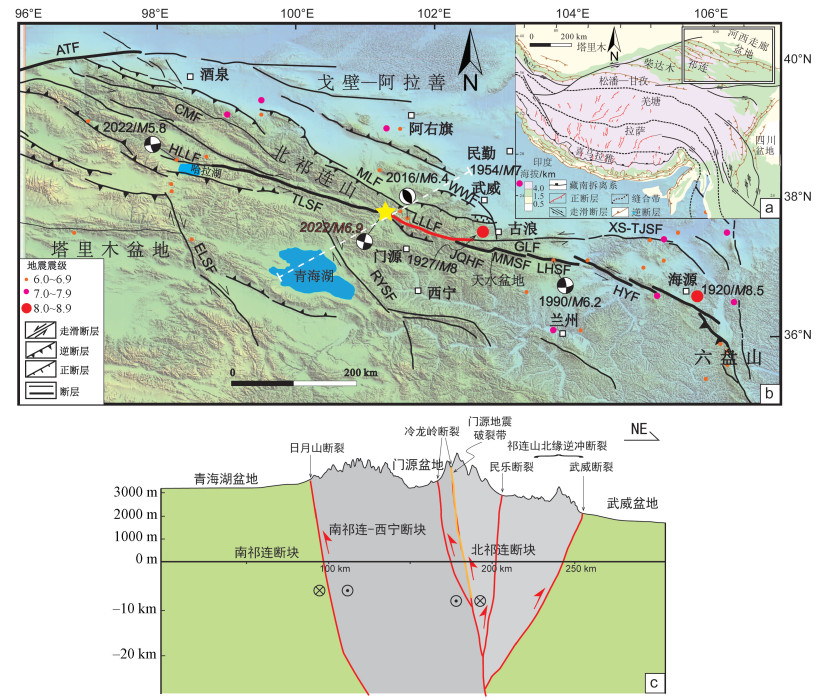
 下载:
下载:
